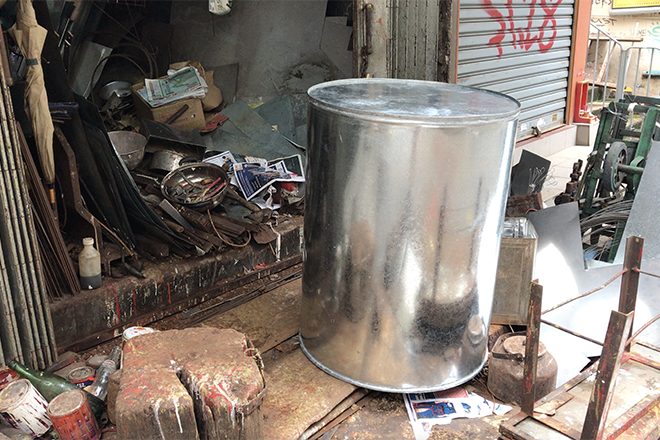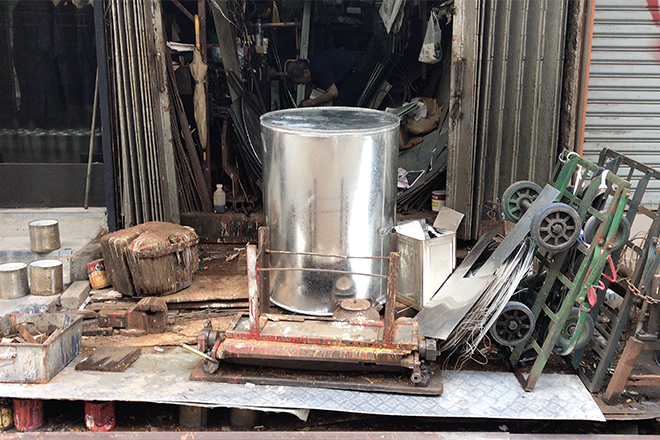By Localiiz
Branded | 17 May 2024
By Localiiz
Branded | 14 May 2024
Copyright © 2025 LOCALIIZ | All rights reserved
Subscribe to our weekly newsletter to get our top stories delivered straight to your inbox.
It is a quiet rainy day on Upper Lascar Row, a street just off of Hollywood Road that is famed for its vast and dizzying collections of antiques and bric-a-brac. Though hip cafes and restaurants have popped up around the area, one shop has remained the same since before World War II. Ho Wing-Sun emerges from the organised chaos of his metalworking workshop, Fuk Li Metal, and greets us with a smile.



“My name is Ho Wing-Sun, kind of like Stanley Ho Hung-Sun, but everyone calls me Har Gor. I’m 75 years old and I’ve been a baak tit lo (白鐵佬) for over 40 years. My dad opened up Fuk Li almost 70 years ago. Our old shop was down the way, but from what I remember, 46A Upper Lascar Row has been our home. We even worked through the Japanese occupation!”
Mr Ho’s day starts around 8 am, when he goes downstairs to the neighbourhood cha chaan teng for his breakfast. He opens up shop at around 9 am, and usually closes before 6 pm. The low chatter on the radio and haggling from tourists at nearby antique stalls keep him company as he toils over sheets of galvanised steel.

Galvanised steel is a light, durable, and inexpensive material that can be made into anything from a mailbox to a shed, making it ubiquitous in Hong Kong in the 1940s. As the use of plastic was introduced and automation and mass production took over, the metalworking industry saw a massive decline. There are now less than 10 metalworking workshops like Fuk Li left in Hong Kong, many of which have made the switch to electrical tools.
You could call Mr Ho a living antique, as his methods haven’t changed a lot since the day he first followed in his father’s footsteps. “I handcraft everything using a pair of cutters, a hammer, and my trusty old bending machine,” he tells us. “Nowadays, I make a living making parts for air conditioning units, but back in our heyday, we would make all sorts of things. Hey, I’m the one who made the donation boxes still in use at Man Mo Temple!”

Mr Ho doesn’t wear gloves, or any safety equipment. He navigates the chaos of his shop with a spring in his step. “Sketch, bend, cut, and hammer! I’ve done this for most of my life, I could draw the blueprints and dimensions in my sleep.”As we watch him measure and then trim down a sheet of metal with a pair of sharpened cutters, Mr Ho laughs, “I should really be wearing gloves, but I can’t feel the metal as well as when I go bare-handed. You can’t make a good product without feeling what you’re working with. I’ve cut my hands loads… Real blood and sweat in my craft, but no tears!” This is a man who has honed his craft to extreme efficiency—crafting a mailbox entirely by hand in less than half an hour.
Read more! Meet the coppersmiths at Hong Kong’s last handcrafted copperware shop.
We asked him if his children would take over when he eventually passes away. “My kids are all grown up, and they have no interest in learning the craft or taking over the shop. They’re doing their own thing. No one wants to learn metalworking, anyway! I don’t blame them. The world is different now. I only got into metalworking because I was a bad student, and my father owned this shop. Now it’s mine, and I’m only still working to pass the time. I am not fussed about passing the craft on. I’m just enjoying myself.”

When he is not bending and cutting steel, you can find Mr Ho eating dim-sum with his neighbours or taking a nap at the back of his shop. Mr Ho has seen the rise and fall of the kitty corners of Upper Lascar Row and remains truly stress-free. No matter what the future holds, Mr Ho will be there with a wide smile and his trusty old sheets of metal.


Top